
|
It is expected to brighten up to 7 mag, and it will be observable in good condition in winter. Now it is 9.6 mag (Nov. 20, Osamu Miyazaki). It will fade out rapidly after this. In the Northern Hemisphere, it stays observable in good condition. In the Southern Hemisphere, it will be getting higher gradually.
Date(TT) R.A. (2000) Decl. Delta r Elong. m1 Best Time(A, h)
Dec. 2 9 47.33 18 15.4 0.606 1.294 106 8.2 5:06 ( 0, 73)
Dec. 9 10 14.31 17 4.3 0.578 1.279 106 7.7 5:05 ( 0, 72)
|

|
It returns for the first time in 70 years. It will brighten up to 4.5 mag in 2024 spring. It suddenly brightened in major outburst by 5 mag up to 11.5 mag on July 20 (E. Tamas, Francois Kugel). It brightened again in another major outburst up to 9.4 mag on Nov. 15 (Nick James). Now it is 8.9 mag (Dec. 3, Osamu Miyazaki). Brightening rapidly. In the Northern Hemisphere, it will be getting lower gradually. In the Southern Hemisphere, it is not observable now.
Date(TT) R.A. (2000) Decl. Delta r Elong. m1 Best Time(A, h)
Dec. 2 18 27.92 38 35.9 2.593 2.378 66 8.6 18:18 (115, 37)
Dec. 9 18 41.60 38 11.9 2.519 2.291 65 8.5 18:18 (116, 34)
|
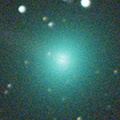
|
It approached to Earth down to 0.2 a.u. in early November, and brightened up to 6.2 mag (Nov. 11, Marco Goiato). Now it is 8.6 mag (Nov. 27, Osamu Miyazaki). Fading rapidly. In the Northern Hemisphere, it will be unobservable in January. In the Southern Hemisphere, it will be getting lower gradually.
Date(TT) R.A. (2000) Decl. Delta r Elong. m1 Best Time(A, h)
Dec. 2 22 19.01 -37 52.5 0.769 1.079 74 10.0 18:18 ( 8, 16)
Dec. 9 22 35.34 -39 58.9 0.996 1.150 70 10.8 18:18 ( 10, 14)
|
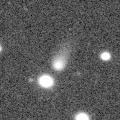
|
It is expected to brighten up to 8.5 mag in early 2024. Now it is 11.2 mag (Nov. 25, Marco Goiato). Brightening slowly. It stays extremely low in the Northern Hemisphere. But it will become high in winter. The brightness evolution slowed down since May.
Date(TT) R.A. (2000) Decl. Delta r Elong. m1 Best Time(A, h)
Dec. 2 13 3.84 -39 58.2 2.225 1.713 47 10.4 5:20 (327, 4)
Dec. 9 13 28.03 -40 0.4 2.145 1.652 47 10.2 5:25 (328, 5)
|

|
It approached to Earth down to 0.38 a.u., and brightened up to 8.0 mag in autumn (Sept. 29, Virgilio Gonano). Now it is 10.2 mag (Nov. 24, Carlos Labordena). It will fade out rapidly after this. It stays observable in good condition.
Date(TT) R.A. (2000) Decl. Delta r Elong. m1 Best Time(A, h)
Dec. 2 9 4.95 -9 22.4 0.569 1.265 105 10.8 4:24 ( 0, 46)
Dec. 9 9 5.11 -11 28.2 0.588 1.316 111 11.2 3:57 ( 0, 43)
|

|
Now it is 11.1 mag (Nov. 18, Thomas Lehmann). Fading slowly. In the Northern Hemisphere, it will be unobservable in January. In the Southern Hemisphere, it will be getting lower gradually. But it will be getting higher again after March.
Date(TT) R.A. (2000) Decl. Delta r Elong. m1 Best Time(A, h)
Dec. 2 23 24.94 -42 51.4 3.141 3.205 84 11.5 18:42 ( 0, 12)
Dec. 9 23 20.70 -42 33.5 3.310 3.258 78 11.7 18:18 ( 2, 13)
|

|
It brightened up to 8 mag from 2022 summer to 2023 spring. Now it is 11.8 mag (Dec. 4, Osamu Miyazaki). Fading slowly. It stays observable in good condition.
Date(TT) R.A. (2000) Decl. Delta r Elong. m1 Best Time(A, h)
Dec. 2 6 10.02 -6 29.6 3.522 4.347 142 12.4 1:30 ( 0, 48)
Dec. 9 6 2.25 -5 50.0 3.545 4.409 147 12.4 0:55 ( 0, 49)
|
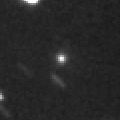
|
It is expected to brighten up to 8.5 mag from January to February. Now it is 13.2 mag (Nov. 22, Thomas Lehmann). Brightening rapidly. It stays observable in good condition. It is fainter than this ephemeris recently.
Date(TT) R.A. (2000) Decl. Delta r Elong. m1 Best Time(A, h)
Dec. 2 2 48.09 16 42.9 0.580 1.532 155 13.2 22:04 ( 0, 72)
Dec. 9 2 48.14 15 51.7 0.572 1.502 148 12.8 21:37 ( 0, 71)
|

|
Now it is 13.7 mag (Nov. 15, Hiroshi Abe). It stays 14 mag for a while. It stays extremely low in the Northern Hemisphere. In the Southern Hemisphere, it stays observable in good condition.
Date(TT) R.A. (2000) Decl. Delta r Elong. m1 Best Time(A, h)
Dec. 2 10 36.47 -35 10.9 4.364 4.241 76 13.2 5:20 (352, 19)
Dec. 9 10 31.42 -36 53.2 4.297 4.273 82 13.2 5:23 ( 0, 18)
|
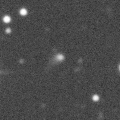
|
Now it is 13.9 mag (Nov. 14, Toshihiko Ikemura, Hirohisa Sato). It stays 13 mag for a while. It stays observable in good condition. It is expected to brighten up to 12 mag from 2024 to 2025.
Date(TT) R.A. (2000) Decl. Delta r Elong. m1 Best Time(A, h)
Dec. 2 9 36.05 7 58.2 4.092 4.457 105 13.4 4:55 ( 0, 63)
Dec. 9 9 31.87 8 52.6 3.933 4.423 113 13.2 4:24 ( 0, 64)
|

|
It brightened up to 7.8 mag in late July (July 20, Thomas Lehmann). Now it is 12.9 mag (Oct. 3, Chris Wyatt). Fading slowly. In the Northern Hemisphere, it will be getting higher gradually. In the Southern Hemisphere, it is not observable now, but it will be observable soon.
Date(TT) R.A. (2000) Decl. Delta r Elong. m1 Best Time(A, h)
Dec. 2 15 12.77 -8 42.9 3.110 2.234 22 13.5 5:20 (284, 5)
Dec. 9 15 14.44 -8 6.1 3.108 2.300 29 13.6 5:25 (288, 11)
|
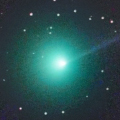
|
It brightened up to 8.1 mag in autumn (Oct. 10, Juan Jose Gonzalez). Fading rapidly. It will be fainter than 18 mag in January. It will never be observable after this.
Date(TT) R.A. (2000) Decl. Delta r Elong. m1 Best Time(A, h)
Dec. 2 17 26.69 -28 7.9 1.894 0.970 14 13.5 18:18 ( 63,-11)
Dec. 9 17 57.97 -28 17.2 2.013 1.084 14 14.4 18:18 ( 62,-10)
|

|
Now it is 13 mag (Nov. 22, Giuseppe Pappa). It stays observable in good condition.
Date(TT) R.A. (2000) Decl. Delta r Elong. m1 Best Time(A, h)
Dec. 2 8 43.38 20 28.9 5.587 6.158 121 13.7 4:03 ( 0, 75)
Dec. 9 8 42.31 20 30.4 5.496 6.160 128 13.6 3:34 ( 0, 75)
|

|
It brightened up to 8.3 mag in 2021-2022 winter (Jan. 6, 2022, Toshiyuki Takahashi). Now it is 13.2 mag (July 14, Chris Wyatt). It stays 14 mag for a while. It stays extremely low in the Northern Hemisphere. In the Southern Hemisphere, it stays observable in good condition.
Date(TT) R.A. (2000) Decl. Delta r Elong. m1 Best Time(A, h)
Dec. 2 11 23.92 -45 30.6 7.187 6.835 65 14.1 5:20 (346, 7)
Dec. 9 11 25.99 -46 30.0 7.164 6.880 69 14.1 5:25 (351, 8)
|

|
Now it is 14.9 mag (Sept. 18, Ken-ichi Kadota). Brightening slowly. It locates somewhat low in the Northern Hemisphere. In the Southern Hemisphere, it is not observable now, but it will be observable soon. It is expected to brighten up to 12.5 mag in 2024 spring. At the high light, it will be observable in excellent condition in the Southern Hemisphere, but it will be low in the Northern Hemisphere.
Date(TT) R.A. (2000) Decl. Delta r Elong. m1 Best Time(A, h)
Dec. 2 15 24.25 -12 16.2 3.811 2.892 18 14.4 5:20 (285, 0)
Dec. 9 15 26.44 -13 30.7 3.737 2.867 24 14.3 5:25 (291, 6)
|

|
Now it is 15.0 mag (Nov. 15, ATLAS Chile). Fading slowly. In the Northern Hemisphere, it is not observable now. In the Southern Hemisphere, it stays observable in good condition. It was expected to brighten up to 10 mag from spring to summer. However, it was fainter than originally expected.
Date(TT) R.A. (2000) Decl. Delta r Elong. m1 Best Time(A, h)
Dec. 2 10 47.26 -85 34.2 3.920 3.665 67 14.5 5:20 (359,-31)
Dec. 9 9 18.63 -86 38.2 3.943 3.701 68 14.6 4:08 ( 0,-32)
|

|
Now it is 15.1 mag (Nov. 17, ATLAS Chile). It stays 14 mag for a while. It stays extremely low in the Northern Hemisphere. In the Southern Hemisphere, it stays observable in good condition.
Date(TT) R.A. (2000) Decl. Delta r Elong. m1 Best Time(A, h)
Dec. 2 11 50.29 -34 37.5 5.827 5.430 61 14.7 5:20 (337, 16)
Dec. 9 11 55.09 -35 14.6 5.728 5.409 66 14.6 5:25 (343, 17)
|
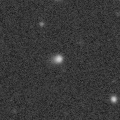
|
It will approach to Sun down to 0.4 a.u. in late September in 2024, and it is expected to brighten up to 0 mag. Now it is 14.7 mag (Dec. 1, Ken-ichi Kadota). It will brighten rapidly after this. In the Northern Hemisphere, it will be getting higher gradually. In the Southern Hemisphere, it is not observable now, but it will be observable soon. At the high light, in the Northern Hemisphere, it will be observable in good condition after the perihelion passage. In the Southern Hemisphere, it will be observable in the low sky before and after the perihelion passage.
Date(TT) R.A. (2000) Decl. Delta r Elong. m1 Best Time(A, h)
Dec. 2 14 46.02 -5 58.4 5.411 4.580 29 14.8 5:20 (286, 12)
Dec. 9 14 49.81 -6 20.4 5.270 4.504 35 14.6 5:25 (291, 17)
|

|
Now it is 14.2 mag (Nov. 15, Ken-ichi Kadota). It stays 15 mag for a while. In the Northern Hemisphere, it stays observable in good condition.
Date(TT) R.A. (2000) Decl. Delta r Elong. m1 Best Time(A, h)
Dec. 2 2 53.73 16 51.1 1.430 2.368 156 14.8 22:10 ( 0, 72)
Dec. 9 2 48.81 17 7.9 1.440 2.338 148 14.7 21:37 ( 0, 72)
|
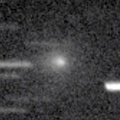
|
It brightened up to 12.6 mag in autumn (Oct. 3, Chris Wyatt). Now it is 15.2 mag (Nov. 21, Ken-ichi Kadota). It will fade out rapidly after this. It will be fainter than 18 mag in January. In the Northern Hemisphere, it stays observable in good condition. It stays extremely low in the Southern Hemisphere.
Date(TT) R.A. (2000) Decl. Delta r Elong. m1 Best Time(A, h)
Dec. 2 20 57.82 -0 55.1 1.312 1.318 68 14.8 18:18 ( 45, 44)
Dec. 9 21 29.92 0 12.1 1.382 1.385 69 15.3 18:18 ( 45, 46)
|
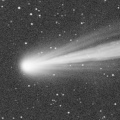
|
It approached to Sun down to 0.23 a.u. and brightened up to 2.5 mag in mid September (Sept. 18, Juan Jose Gonzalez). Now it is 11.5 mag (Nov. 22, Giuseppe Pappa). Fading rapidly. It will be fainter than 18 mag in January. In the Northern Hemisphere, it will be unobservable in January. In the Southern Hemisphere, it stays observable in good condition. It is brighter than this ephemeris recently.
Date(TT) R.A. (2000) Decl. Delta r Elong. m1 Best Time(A, h)
Dec. 2 12 46.66 -42 54.2 2.211 1.758 50 14.9 5:20 (331, 3)
Dec. 9 12 41.41 -45 20.4 2.229 1.875 56 15.4 5:25 (338, 5)
|

|
Now it is 14.7 mag (Nov. 1, Ken-ichi Kadota). Fading slowly. It will be getting lower gradually after this, and it will be unobservable in January in the Southern Hemisphere, or in February in the Northern Hemisphere. But it will be observable again in March in the Northern Hemisphere, or in April in the Southern Hemisphere.
Date(TT) R.A. (2000) Decl. Delta r Elong. m1 Best Time(A, h)
Dec. 2 22 39.38 3 1.0 3.502 3.692 93 14.9 18:18 ( 10, 58)
Dec. 9 22 35.57 3 3.8 3.670 3.724 85 15.0 18:18 ( 24, 56)
|
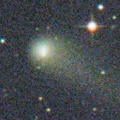
|
It brightened up to 11.1 mag in early 2022 (Mar. 31, 2022, F. Kugel, J.-G. Bosch, J. Nicolas). Now it is 14.3 mag (Nov. 3, Hiroshi Abe). It stays 15 mag for a while. In the Northern Hemisphere, it will be getting higher gradually. In the Southern Hemisphere, it is not observable now, but it will appear in February.
Date(TT) R.A. (2000) Decl. Delta r Elong. m1 Best Time(A, h)
Dec. 2 16 36.26 15 45.9 6.823 6.072 37 15.1 18:18 (106, 4)
Dec. 9 16 42.29 15 54.3 6.845 6.110 38 15.1 5:25 (256, 7)
|

|
Now it is 15.9 mag (Nov. 17, ATLAS Chile). Fading gradually. In the Northern Hemisphere, it will be getting higher gradually. In the Southern Hemisphere, it will be getting lower gradually after this, and it will be unobservable in March.
Date(TT) R.A. (2000) Decl. Delta r Elong. m1 Best Time(A, h)
Dec. 2 0 36.93 -30 0.1 1.278 1.790 103 15.3 19:53 ( 0, 25)
Dec. 9 0 37.12 -24 58.1 1.319 1.782 100 15.3 19:26 ( 0, 30)
|
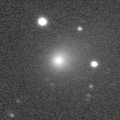
|
The ATLAS search program detected its cometary activity in April. It continues to be brightening even after the perihelion passage. Now it is 14.8 mag (Nov. 18, Thomas Lehmann). It will fade out rapidly after this. It will be fainter than 18 mag in February. In the Northern Hemisphere, it stays observable in good condition. In the Southern Hemisphere, it will be getting lower gradually.
Date(TT) R.A. (2000) Decl. Delta r Elong. m1 Best Time(A, h)
Dec. 2 23 40.20 -18 41.8 3.157 3.442 98 15.4 18:57 ( 0, 37)
Dec. 9 23 44.20 -17 30.6 3.292 3.484 92 15.6 18:34 ( 0, 38)
|
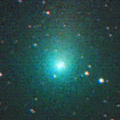
|
It brightened up to 9.5 mag from last winter to early spring (Jan. 30, Katsumi Yoshimoto). Now it is 14.9 mag (Nov. 15, Thomas Lehmann). Fading gradually. It will be fainter than 18 mag in March. It will be getting lower gradually after this, and it will be unobservable in February.
Date(TT) R.A. (2000) Decl. Delta r Elong. m1 Best Time(A, h)
Dec. 2 22 34.20 -12 32.2 3.738 3.804 86 15.6 18:18 ( 9, 42)
Dec. 9 22 36.08 -13 7.2 3.926 3.869 79 15.8 18:18 ( 17, 40)
|

|
David Rankin detected its cometary activity in June. Now it is 15.7 mag (Nov. 13, Toshihiko Ikemura, Hirohisa Sato). Fading gradually. It will be fainter than 18 mag in April. In the Northern Hemisphere, it stays observable in good condition. In the Southern Hemisphere, it will be getting lower gradually after this, and it will be unobservable in March.
Date(TT) R.A. (2000) Decl. Delta r Elong. m1 Best Time(A, h)
Dec. 2 22 49.73 -1 23.7 1.820 2.130 94 15.7 18:18 ( 4, 54)
Dec. 9 23 0.12 -0 32.7 1.889 2.126 89 15.7 18:18 ( 12, 54)
|
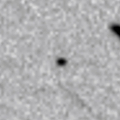
|
It will approach to Earth down to 0.2 a.u. from February to March, and it is expected to brighten up to 13 mag. Now it is 18.1 mag (Nov. 13, Toshihiko Ikemura, Hirohisa Sato). It will brighten rapidly after this. It stays observable in good condition.
Date(TT) R.A. (2000) Decl. Delta r Elong. m1 Best Time(A, h)
Dec. 2 23 52.89 -10 0.2 0.630 1.300 104 16.1 19:10 ( 0, 45)
Dec. 9 23 56.44 -11 16.4 0.617 1.235 98 15.9 18:46 ( 0, 44)
|

|
It has not been observed yet in this apparition. It was expected to brighten rapidly up to 15 mag in summer. But actually, it is not detected, fainter than 18 mag (Oct. 14, Martin Masek). Fading slowly. It will be unobservable in January in the Southern Hemisphere, or in February in the Northern Hemisphere.
Date(TT) R.A. (2000) Decl. Delta r Elong. m1 Best Time(A, h)
Dec. 2 20 15.32 -17 39.0 2.419 1.987 52 15.9 18:18 ( 44, 25)
Dec. 9 20 31.20 -16 22.2 2.480 1.992 49 16.0 18:18 ( 47, 24)
|
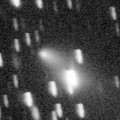
|
It brightened up to 13.6 mag in summer (July 16, Mitsunori Tsumura). Now it is 15.7 mag (Nov. 21, Ken-ichi Kadota). It will fade out rapidly after this. It will be fainter than 18 mag in February. In the Northern Hemisphere, it stays observable in good condition. In the Southern Hemisphere, it will never be observable after this.
Date(TT) R.A. (2000) Decl. Delta r Elong. m1 Best Time(A, h)
Dec. 2 23 14.87 67 3.4 1.735 2.322 114 15.9 18:31 (180, 58)
Dec. 9 23 17.42 66 8.4 1.811 2.369 112 16.1 18:18 (178, 59)
|
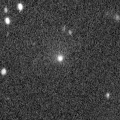
|
Very large comet. It is expected to brighten up to 13 mag in 2031. Now it is 15.9 mag (Nov. 22, Thomas Lehmann). It stays 16 mag for a while. In the Northern Hemisphere, it is not observable now. In the Southern Hemisphere, it stays observable in good condition. In the Northern Hemisphere, it is not observable until 2030.
Date(TT) R.A. (2000) Decl. Delta r Elong. m1 Best Time(A, h)
Dec. 2 3 5.25 -66 2.6 16.915 16.955 90 16.0 22:20 ( 0,-11)
Dec. 9 3 2.39 -65 58.5 16.928 16.930 88 16.0 21:50 ( 0,-11)
|

|
Now it is 14.3 mag (July 7, Thomas Lehmann). It stays 16 mag for a while. In the Northern Hemisphere, it is not observable now, but it will appear in January. In the Southern Hemisphere, it will be getting higher gradually.
Date(TT) R.A. (2000) Decl. Delta r Elong. m1 Best Time(A, h)
Dec. 2 15 6.37 -48 48.7 3.999 3.202 31 16.0 5:20 (318,-18)
Dec. 9 15 18.53 -48 42.9 4.043 3.260 32 16.1 5:25 (320,-15)
|

|
Now it is 16.1 mag (Nov. 29, Ken-ichi Kadota). It stays 16 mag for a while. In the Northern Hemisphere, it will be unobservable in March. In the Southern Hemisphere, it stays observable in good condition. The brightness evolution is slower than originally expected.
Date(TT) R.A. (2000) Decl. Delta r Elong. m1 Best Time(A, h)
Dec. 2 2 11.65 -26 31.8 2.993 3.603 121 16.1 21:27 ( 0, 28)
Dec. 9 2 3.95 -27 40.7 3.044 3.560 113 16.1 20:52 ( 0, 27)
|
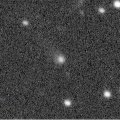
|
Now it is 16.8 mag (Nov. 11, ATLAS South Africa). It stays 16 mag for a while. In the Northern Hemisphere, it will never be observable after this. In the Southern Hemisphere, it stays observable in good condition.
Date(TT) R.A. (2000) Decl. Delta r Elong. m1 Best Time(A, h)
Dec. 2 9 31.93 -58 18.1 3.812 3.747 78 16.1 4:51 ( 0, -3)
Dec. 9 9 24.03 -61 8.2 3.783 3.757 80 16.1 4:15 ( 0, -6)
|

|
New peridic comet which brightened up to 16 mag in 2007. It has not been recovered yet. It was missed in 2013 and 2018. It will approach to Earth down to 0.34 a.u. in winter, and it is expected to brighten up to 16 mag. It will fade out rapidly after this. It will be fainter than 18 mag in January. In the Northern Hemisphere, it will be getting higher gradually. It stays extremely low in the Southern Hemisphere.
Date(TT) R.A. (2000) Decl. Delta r Elong. m1 Best Time(A, h)
Dec. 2 19 34.57 -14 36.7 0.549 0.706 44 16.4 18:18 ( 54, 21)
Dec. 9 20 12.59 -7 34.5 0.457 0.763 48 16.2 18:18 ( 57, 28)
|
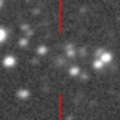
|
Now it is 17.3 mag (Nov. 14, ATLAS Chile). Fading slowly. It will be unobservable in January. But it will be observable again in March in the Southern Hemisphere.
Date(TT) R.A. (2000) Decl. Delta r Elong. m1 Best Time(A, h)
Dec. 2 19 58.89 -33 51.7 3.608 3.026 47 16.3 18:18 ( 37, 9)
Dec. 9 20 11.41 -33 31.0 3.684 3.040 43 16.4 18:18 ( 40, 8)
|
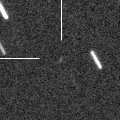
|
It is expected to brighten up to 16 mag in winter. Now it is 17.7 mag (Nov. 14, Toshihiko Ikemura, Hirohisa Sato). Fading slowly. In the Northern Hemisphere, it will be getting lower gradually. In the Southern Hemisphere, it will be getting higher gradually. It is fainter than this ephemeris recently.
Date(TT) R.A. (2000) Decl. Delta r Elong. m1 Best Time(A, h)
Dec. 2 11 51.56 -1 53.7 2.206 2.093 70 16.4 5:20 (319, 45)
Dec. 9 11 47.75 -5 2.8 2.095 2.108 77 16.3 5:25 (333, 46)
|

|
Fading gradually. It will be fainter than 18 mag in January. In the Northern Hemisphere, it stays observable in good condition. It stays extremely low in the Southern Hemisphere.
Date(TT) R.A. (2000) Decl. Delta r Elong. m1 Best Time(A, h)
Dec. 2 20 35.44 5 23.5 0.957 1.057 65 16.4 18:18 ( 57, 46)
Dec. 9 21 13.26 7 20.2 1.075 1.165 68 16.7 18:18 ( 56, 49)
|

|
It approached to Earth down to 0.29 a.u. in early February, and it brightened up to 4.5 mag (Feb. 1, Juan Jose Gonzalez). Now it is 16.1 mag (Nov. 15, ATLAS Chile). Fading slowly. It will be fainter than 18 mag in March. In the Northern Hemisphere, it will never be observable after this. In the Southern Hemisphere, it stays observable in good condition.
Date(TT) R.A. (2000) Decl. Delta r Elong. m1 Best Time(A, h)
Dec. 2 4 40.38 -62 52.7 4.138 4.341 95 16.5 23:54 ( 0, -8)
Dec. 9 4 22.09 -62 54.6 4.231 4.411 94 16.6 23:08 ( 0, -8)
|
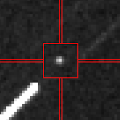
|
Now it is 16.2 mag (Nov. 18, Giuseppe Pappa). Fading slowly. It will be unobservable in January. But it will be observable again in February.
Date(TT) R.A. (2000) Decl. Delta r Elong. m1 Best Time(A, h)
Dec. 2 22 48.46 -38 39.9 0.881 1.202 79 16.5 18:18 ( 3, 16)
Dec. 9 22 13.66 -39 4.8 1.039 1.119 67 16.6 18:18 ( 15, 14)
|

|
Now it is 16.0 mag (Nov. 14, Toshihiko Ikemura, Hirohisa Sato). It stays 17 mag for a while. It stays observable in good condition.
Date(TT) R.A. (2000) Decl. Delta r Elong. m1 Best Time(A, h)
Dec. 2 4 45.46 -12 46.2 6.355 7.186 145 16.6 0:05 ( 0, 42)
Dec. 9 4 42.76 -12 39.0 6.332 7.155 144 16.6 23:31 ( 0, 42)
|
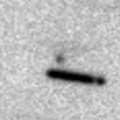
|
It returned for the first time in 68 years. It will brighten up to 7.5 mag in 2024 summer. Now it is 17.5 mag (Nov. 14, ATLAS Chile). It will brighten rapidly after this. It stays observable in good condition. At the high light, it locates low in the Northern Hemisphere, or it is not observable in the Southern Hemisphere.
Date(TT) R.A. (2000) Decl. Delta r Elong. m1 Best Time(A, h)
Dec. 2 3 36.40 -20 39.8 2.248 3.031 135 16.9 22:52 ( 0, 34)
Dec. 9 3 27.57 -19 52.2 2.211 2.959 131 16.6 22:15 ( 0, 35)
|

|
It will turn to fade out rapidly after brightening. It will be fainter than 18 mag in February. It stays extremely low. It will brighten up to 13 mag in January. But it locates extremely low.
Date(TT) R.A. (2000) Decl. Delta r Elong. m1 Best Time(A, h)
Dec. 2 14 13.32 -19 3.0 1.833 1.127 32 18.0 5:20 (301, 9)
Dec. 9 14 44.51 -19 45.1 1.814 1.105 31 16.6 5:25 (302, 9)
|
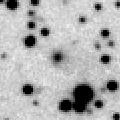
|
Now it is 16.8 mag (Nov. 4, ATLAS-HKO, Haleakala). It stays 17 mag for a while. In the Northern Hemisphere, it stays observable in good condition. It stays extremely low in the Southern Hemisphere.
Date(TT) R.A. (2000) Decl. Delta r Elong. m1 Best Time(A, h)
Dec. 2 4 48.82 41 46.4 5.759 6.693 159 16.6 0:09 (180, 83)
Dec. 9 4 45.73 41 46.9 5.754 6.691 160 16.6 23:34 (180, 83)
|

|
It brightened up to 11.8 mag in summer (June 17, Osamu Miyazaki). Now it is 16.5 mag (Nov. 14, Toshihiko Ikemura, Hirohisa Sato). It will fade out rapidly after this. It will be fainter than 18 mag in January. In the Northern Hemisphere, it will be getting lower gradually. In the Southern Hemisphere, it will be unobservable in January.
Date(TT) R.A. (2000) Decl. Delta r Elong. m1 Best Time(A, h)
Dec. 2 21 13.59 -2 13.5 2.642 2.509 71 16.7 18:18 ( 40, 45)
Dec. 9 21 24.70 -1 46.5 2.751 2.539 67 16.9 18:18 ( 45, 43)
|
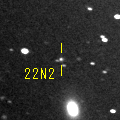
|
It is expected to brighten up to 11.5 mag in 2025 autumn, and it will be observable in good condition. Now it is 17.1 mag (Nov. 14, ATLAS Chile). It stays 16 mag for a while. It will be unobservable in January. But it will be observable again in March in the Southern Hemisphere, or in April in the Northern Hemisphere.
Date(TT) R.A. (2000) Decl. Delta r Elong. m1 Best Time(A, h)
Dec. 2 20 47.37 -18 8.9 6.779 6.346 60 16.7 18:18 ( 36, 28)
Dec. 9 20 51.19 -17 50.9 6.832 6.303 53 16.7 18:18 ( 42, 25)
|
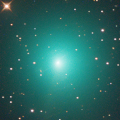
|
It brightened up to 8.4 mag in late July (July 22, Thomas Lehmann). Now it is 18.4 mag (Nov. 15, Toshihiko Ikemura, Hirohisa Sato). Fading rapidly. It will be fainter than 18 mag in January. It locates somewhat low in the Northern Hemisphere. In the Southern Hemisphere, it will be getting lower gradually. Thomas Lehmann reported it was bright as 14.9 mag on Nov. 18.
Date(TT) R.A. (2000) Decl. Delta r Elong. m1 Best Time(A, h)
Dec. 2 23 24.46 -24 4.0 2.213 2.465 92 16.7 18:42 ( 0, 31)
Dec. 9 23 32.43 -23 25.0 2.381 2.544 87 17.1 18:22 ( 0, 32)
|
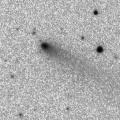
|
Now it is 16.5 mag (Nov. 16, ATLAS Chile). Fading slowly. It will be fainter than 18 mag in March. In the Northern Hemisphere, it stays observable in good condition. In the Southern Hemisphere, it will be getting lower gradually after this, and it will be unobservable in March.
Date(TT) R.A. (2000) Decl. Delta r Elong. m1 Best Time(A, h)
Dec. 2 0 4.30 -7 20.1 3.387 3.819 108 16.7 19:21 ( 0, 48)
Dec. 9 0 5.72 -6 50.1 3.504 3.835 102 16.8 18:55 ( 0, 48)
|
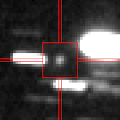
|
It is expected to brighten up to 12.5 mag in 2024 summer. Now it is 17.3 mag (July 28, ATLAS South Africa). Brightening slowly. In the Northern Hemisphere, it is not observable now. In the Southern Hemisphere, it stays observable in good condition. Around the high light, it is observable in good condition in the Southern Hemisphere, but it locates very low in the Northern Hemisphere.
Date(TT) R.A. (2000) Decl. Delta r Elong. m1 Best Time(A, h)
Dec. 2 13 25.72 -53 46.9 4.962 4.351 47 16.9 5:20 (332, -9)
Dec. 9 13 36.97 -54 58.5 4.871 4.296 49 16.8 5:25 (335, -8)
|
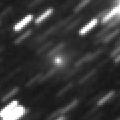
|
Very far object. Now it is 17.3 mag (Nov. 17, Jean-Claude Merlin). It stays 17 mag for a while. In the Northern Hemisphere, it is not observable now. In the Southern Hemisphere, it stays observable in good condition.
Date(TT) R.A. (2000) Decl. Delta r Elong. m1 Best Time(A, h)
Dec. 2 3 29.90 -77 7.0 10.428 10.313 80 16.8 22:43 ( 0,-22)
Dec. 9 3 14.47 -76 44.9 10.452 10.314 79 16.8 22:00 ( 0,-22)
|

|
Now it is 17.3 mag (Nov. 15, A. Diepvens). It stays 17 mag for a while. In the Northern Hemisphere, it stays observable in good condition. It locates somewhat low in the Southern Hemisphere. But it will become high in autumn.
Date(TT) R.A. (2000) Decl. Delta r Elong. m1 Best Time(A, h)
Dec. 2 4 54.44 36 44.5 4.219 5.174 164 16.8 0:15 (180, 88)
Dec. 9 4 50.68 36 9.4 4.192 5.155 166 16.8 23:39 (180, 89)
|

|
It brightened up to 14.1 mag in 2022 spring (Mar. 22, 2022, Chris Wyatt). Now it is 16.6 mag (Nov. 29, Ken-ichi Kadota). Fading slowly. It will be fainter than 18 mag in April. It will be getting lower gradually after this, and it will be unobservable in March.
Date(TT) R.A. (2000) Decl. Delta r Elong. m1 Best Time(A, h)
Dec. 2 1 32.10 -1 14.4 5.047 5.740 130 16.8 20:48 ( 0, 54)
Dec. 9 1 27.77 -0 50.8 5.190 5.788 123 16.9 20:16 ( 0, 54)
|
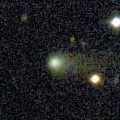
|
It brightened up to 13.9 mag in early 2023 (Jan. 21, Hidenori Nohara). Now it is 16.3 mag (June 17, Ken-ichi Kadota). It stays 17 mag for a while. In the Northern Hemisphere, it stays observable in good condition. In the Southern Hemisphere, it is not observable now, but it will be observable soon.
Date(TT) R.A. (2000) Decl. Delta r Elong. m1 Best Time(A, h)
Dec. 2 13 53.79 7 3.3 4.920 4.323 47 16.9 5:20 (283, 30)
Dec. 9 14 0.70 6 46.8 4.883 4.361 52 16.9 5:25 (288, 35)
|
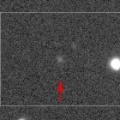
|
It will be observable at 15-16 mag from 2024 to 2025. Now it is 17.9 mag (Apr. 25, A. Diepvens). Brightening slowly. In the Northern Hemisphere, it stays observable in good condition. In the Southern Hemisphere, it will be getting higher gradually.
Date(TT) R.A. (2000) Decl. Delta r Elong. m1 Best Time(A, h)
Dec. 2 12 42.33 3 48.7 4.206 3.831 61 17.1 5:20 (301, 41)
Dec. 9 12 48.37 3 17.9 4.097 3.816 66 17.0 5:25 (308, 45)
|
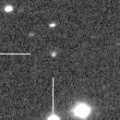
|
It stays 17 mag for a while. It locates somewhat low in the Northern Hemisphere. But it will become high in summer. In the Southern Hemisphere, it will be getting higher gradually.
Date(TT) R.A. (2000) Decl. Delta r Elong. m1 Best Time(A, h)
Dec. 2 12 48.15 -21 47.7 4.051 3.519 51 17.2 5:20 (319, 21)
Dec. 9 12 57.31 -22 40.8 3.966 3.506 55 17.1 5:25 (324, 23)
|

|
Now it is 16.7 mag (Nov. 13, Jean-Claude Merlin). It stays 17 mag for a while. It stays extremely low in the Northern Hemisphere. In the Southern Hemisphere, it stays observable in good condition.
Date(TT) R.A. (2000) Decl. Delta r Elong. m1 Best Time(A, h)
Dec. 2 5 3.93 -41 5.5 7.301 7.792 116 17.2 0:23 ( 0, 14)
Dec. 9 5 1.13 -41 5.0 7.283 7.768 116 17.2 23:49 ( 0, 14)
|
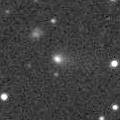
|
Now it is 16.1 mag (Nov. 14, Toshihiko Ikemura, Hirohisa Sato). Fading slowly. It will be fainter than 18 mag in January. It stays observable in good condition.
Date(TT) R.A. (2000) Decl. Delta r Elong. m1 Best Time(A, h)
Dec. 2 3 28.56 4 4.3 2.241 3.171 156 17.2 22:44 ( 0, 59)
Dec. 9 3 24.61 4 6.7 2.292 3.185 150 17.3 22:13 ( 0, 59)
|

|
Now it is 16.9 mag (Nov. 12, ATLAS-HKO, Haleakala). It stays 18 mag for a while. In the Northern Hemisphere, it stays observable in good condition. It stays extremely low in the Southern Hemisphere.
Date(TT) R.A. (2000) Decl. Delta r Elong. m1 Best Time(A, h)
Dec. 2 22 50.13 47 37.1 3.884 4.311 109 17.3 18:18 (172, 77)
Dec. 9 22 43.89 45 52.5 3.962 4.298 103 17.3 18:18 (145, 76)
|

|
First return of a new periodic comet which brightened up to 10 mag in 2001. It is expected to brighten up to 12-13 mag from February to March in 2024. It will brighten rapidly after this. In the Northern Hemisphere, it stays observable in good condition. In the Southern Hemisphere, it will be getting lower gradually after this, and it will be unobservable in January.
Date(TT) R.A. (2000) Decl. Delta r Elong. m1 Best Time(A, h)
Dec. 2 23 8.21 -23 28.5 1.522 1.808 89 17.5 18:25 ( 0, 32)
Dec. 9 23 6.93 -19 5.7 1.557 1.755 84 17.4 18:18 ( 6, 36)
|

|
Now it is 17.2 mag (Nov. 15, A. Diepvens). Fading slowly. It will be fainter than 18 mag in January. In the Northern Hemisphere, it will be getting lower gradually. It locates somewhat low in the Southern Hemisphere. It was very faint as 21.5 mag in 2021. It seems to be bright temporarily in outburst.
Date(TT) R.A. (2000) Decl. Delta r Elong. m1 Best Time(A, h)
Dec. 2 21 25.59 -10 41.0 4.914 4.691 71 17.5 18:18 ( 31, 39)
Dec. 9 21 30.28 -10 19.0 5.030 4.705 65 17.6 18:18 ( 37, 37)
|
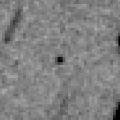
|
Now it is 19.5 mag (Nov. 12, Toshihiko Ikemura, Hirohisa Sato). Brightening slowly. In the Northern Hemisphere, it stays observable in good condition. It locates somewhat low in the Southern Hemisphere.
Date(TT) R.A. (2000) Decl. Delta r Elong. m1 Best Time(A, h)
Dec. 2 7 38.21 32 46.3 1.024 1.871 137 17.8 2:58 ( 0, 88)
Dec. 9 7 41.93 33 43.6 0.955 1.840 143 17.5 2:34 ( 0, 89)
|
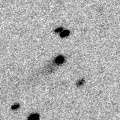
|
Now it is 17.0 mag (Apr. 11, Michael Jager). It stays 18 mag for a while. In the Northern Hemisphere, it stays observable in good condition. In the Southern Hemisphere, it will be getting higher gradually.
Date(TT) R.A. (2000) Decl. Delta r Elong. m1 Best Time(A, h)
Dec. 2 12 33.46 12 59.7 9.618 9.288 67 17.6 5:20 (293, 49)
Dec. 9 12 33.49 13 13.9 9.514 9.300 74 17.6 5:25 (302, 55)
|

|
It is expected to brighten up to 13 mag in early summer in 2024. Now it is 18.3 mag (Nov. 13, Jean-Claude Merlin). Brightening gradually. It locates somewhat low in the Northern Hemisphere. In the Southern Hemisphere, it stays observable in good condition. At the high light, it is not observable in the Southern Hemisphere, or it locates low in the Northern Hemisphere.
Date(TT) R.A. (2000) Decl. Delta r Elong. m1 Best Time(A, h)
Dec. 2 2 59.45 -46 33.4 2.341 2.815 108 17.8 22:14 ( 0, 9)
Dec. 9 2 45.91 -44 50.5 2.298 2.736 105 17.7 21:33 ( 0, 10)
|
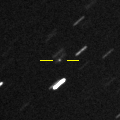
|
It brightens up to 16 mag from January to February. Now it is 18.0 mag (Nov. 15, Ken-ichi Kadota). Brightening slowly. It stays observable in good condition.
Date(TT) R.A. (2000) Decl. Delta r Elong. m1 Best Time(A, h)
Dec. 2 9 0.79 9 5.5 1.378 1.994 114 17.9 4:20 ( 0, 64)
Dec. 9 9 6.04 6 51.6 1.288 1.965 118 17.7 3:58 ( 0, 62)
|
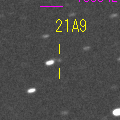
|
Now it is 18.3 mag (Nov. 21, Ken-ichi Kadota). It stays 18 mag for a while. It stays observable in good condition.
Date(TT) R.A. (2000) Decl. Delta r Elong. m1 Best Time(A, h)
Dec. 2 7 19.63 9 33.1 7.004 7.760 137 17.7 2:39 ( 0, 65)
Dec. 9 7 14.31 9 25.5 6.930 7.760 145 17.7 2:07 ( 0, 64)
|

|
It brightened up to 13.4 mag in 2022 summer (July 7, 2022, Giuseppe Pappa). Now it is 18.6 mag (Oct. 2, ATLAS-HKO, Haleakala). It stays 18 mag for a while. In the Northern Hemisphere, it will be getting higher gradually. In the Southern Hemisphere, it will never be observable after this.
Date(TT) R.A. (2000) Decl. Delta r Elong. m1 Best Time(A, h)
Dec. 2 16 0.98 30 40.0 5.632 5.099 52 17.8 5:20 (244, 17)
Dec. 9 16 5.24 31 16.6 5.640 5.148 55 17.8 5:25 (247, 23)
|

|
Now it is 18.8 mag (Nov. 14, Toshihiko Ikemura, Hirohisa Sato). It stays 18 mag for a while. It stays observable in good condition.
Date(TT) R.A. (2000) Decl. Delta r Elong. m1 Best Time(A, h)
Dec. 2 4 50.45 24 5.0 3.151 4.133 174 17.8 0:11 ( 0, 79)
Dec. 9 4 45.80 23 45.5 3.150 4.134 176 17.8 23:34 ( 0, 79)
|
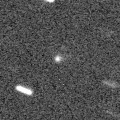
|
Now it is 17.2 mag (Nov. 13, Toshihiko Ikemura, Hirohisa Sato). It stays 18 mag for a while. In the Northern Hemisphere, it stays observable in good condition. In the Southern Hemisphere, it will be getting lower gradually.
Date(TT) R.A. (2000) Decl. Delta r Elong. m1 Best Time(A, h)
Dec. 2 1 23.90 -2 47.5 2.090 2.810 128 17.9 20:40 ( 0, 52)
Dec. 9 1 22.08 -2 33.2 2.133 2.773 121 17.9 20:11 ( 0, 53)
|
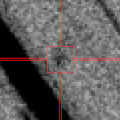
|
Tiny member of Comet C/1988 A1 ( Liller )'s group. Now it is 17.5 mag (Nov. 17, Giuseppe Pappa). It will fade out rapidly after this. In the Northern Hemisphere, it will be getting lower gradually. In the Southern Hemisphere, it is not observable now.
Date(TT) R.A. (2000) Decl. Delta r Elong. m1 Best Time(A, h)
Dec. 2 19 6.56 24 45.4 0.679 0.875 60 19.1 18:18 ( 96, 39)
Dec. 9 18 49.76 26 12.6 0.810 0.852 55 19.3 18:18 (103, 30)
|
|
![]()
 126P/IRAS
126P/IRAS C/2014 UN271 ( Bernardinelli-Bernstein )
C/2014 UN271 ( Bernardinelli-Bernstein ) C/2021 Y1 ( ATLAS )
C/2021 Y1 ( ATLAS ) C/2022 S4 ( Lemmon )
C/2022 S4 ( Lemmon ) C/2022 A3 ( Lemmon-ATLAS )
C/2022 A3 ( Lemmon-ATLAS ) P/2007 T2 ( Kowalski )
P/2007 T2 ( Kowalski ) 199P/Shoemaker 4
199P/Shoemaker 4 C/2022 V2 ( Lemmon )
C/2022 V2 ( Lemmon ) (3200) Phaethon
(3200) Phaethon C/2022 E3 ( ZTF )
C/2022 E3 ( ZTF ) C/2023 S3 ( Lemmon )
C/2023 S3 ( Lemmon ) C/2022 QE78 ( ATLAS )
C/2022 QE78 ( ATLAS ) 13P/Olbers
13P/Olbers 26P/Grigg-Skjellerup
26P/Grigg-Skjellerup C/2021 S4 ( Tsuchinshan )
C/2021 S4 ( Tsuchinshan ) 237P/LINEAR
237P/LINEAR C/2022 N2 ( PanSTARRS )
C/2022 N2 ( PanSTARRS ) C/2023 E1 ( ATLAS )
C/2023 E1 ( ATLAS ) 117P/Helin-Roman-Alu 1
117P/Helin-Roman-Alu 1 C/2023 C2 ( ATLAS )
C/2023 C2 ( ATLAS ) C/2019 E3 ( ATLAS )
C/2019 E3 ( ATLAS ) C/2022 U3 ( Bok )
C/2022 U3 ( Bok ) C/2020 Y2 ( ATLAS )
C/2020 Y2 ( ATLAS ) C/2020 S4 ( PanSTARRS )
C/2020 S4 ( PanSTARRS ) 65P/Gunn
65P/Gunn C/2022 T1 ( Lemmon )
C/2022 T1 ( Lemmon ) C/2022 R6 ( PanSTARRS )
C/2022 R6 ( PanSTARRS ) 170P/Christensen
170P/Christensen C/2022 U1 ( Leonard )
C/2022 U1 ( Leonard ) P/2001 Q6 ( NEAT )
P/2001 Q6 ( NEAT ) P/2023 M4 ( ATLAS )
P/2023 M4 ( ATLAS ) 227P/Catalina-LINEAR
227P/Catalina-LINEAR C/2020 F2 ( ATLAS )
C/2020 F2 ( ATLAS ) C/2023 V4 ( Camarasa-Duszanowicz )
C/2023 V4 ( Camarasa-Duszanowicz ) 150P/LONEOS
150P/LONEOS C/2021 A9 ( PanSTARRS )
C/2021 A9 ( PanSTARRS ) C/2020 R7 ( ATLAS )
C/2020 R7 ( ATLAS ) 404P/2020 M6 ( Bressi )
404P/2020 M6 ( Bressi ) 30P/Reinmuth 1
30P/Reinmuth 1 C/2023 V5 ( Leonard )
C/2023 V5 ( Leonard )![]()





























































